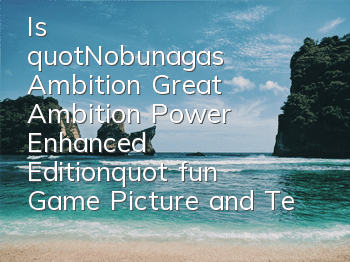As usual, the Power Enhanced Edition is the true face of "Nobunaga's Ambitions".
From the recent works, the Glorious History Simulation Game seems to have fallen into an unfinished cycle - adding a system of control and chaos. Whether it is Creation that simplifies excessive combat systems, or the strange internal logic of "breaking hands" in "Romance of the Three Kingdoms 13".
Similarly, this new work failed to escape the vicious circle. After "Dazhi" was launched, it encountered more doubts than its predecessors. The mild attempt first angered the old players, and then discouraged the new players. Therefore, he embarked on a long road of renewal. After a full year of revision, he finally released "Nobunaga's Ambition: Da Ambition with Power Enhanced Edition" (hereinafter referred to as "Dashima Power Enhanced Edition").
According to previously disclosed information, the changes to "Power Strengthening Edition" include all aspects of internal affairs, war and diplomacy, and the number of original versions is rare in the history of the series. After we experience it, we can at least say that this "new work" has finally become "complete".
Big Destiny and Ambition
About the core system of "Dazhi" - in the original version, it was introduced in the new version as a creative alternative to "creation". But relatively speaking, the weight of this new core element in the original version is actually not high.
Oda Nobunaga's "life"
Here we can make a small comparison with the previous work "Creation". In "Creation", the concept of "creation" is at the core of the entire game conception. Each general has three tendencies: "creation, middle way, and conservatism" that are actually a "ideological" system, corresponding to three different "power value orientations". On this basis, different policies are designed to provide players with choices. At the same time, the unique policies based on creativity of each company further strengthen the differences between forces and forces, and maintain the freshness of players in each game.
In the original work of "Dazhi", this gameplay that can be called "core system" was completely deleted - there is nothing to criticize. The design principle of "core system changes with the theme" in the series of works of "Nobunaga's Ambition" and "The Three Kingdoms" determines this development idea, but the integration of "Chi" itself with other modules of the system in the new work is not high - it does not penetrate into internal affairs and diplomacy like creativity, and affects the players' operations of power globally, but rather, by customizing unique "Chi" for a small number of unique daimyos, each daimyo provides a total of eight bonuses to different domain attributes to achieve differentiation between daimyos.
The problem lies in the inconsistent nature of Shin-gen itself - if you are Takeda Shin-gen, of course you can follow the gloriously set Shin-gen and experience Shin-gen's life - but if you are Takeda Shin-toe, it will be embarrassing. You can only be framed in the framework of "family name survival" and cannot be modified, which objectively brings a reduction in strategy freedom.
Hiderai Toyotomi
This finished product state, which is not in-depth enough, has attracted bad comments from players. In the Power Enhanced Edition, Glory introduced a "life" system similar to the "policy system" of P Society as a supplement to the magazine system. Those who have played with stars will know that there is a system among stars that can consume rare resources to obtain short-term policy bonuses including population/economic/prestige growth rate, fleet combat power, etc.
In Dazhi PK, you can also do this, by consuming Dasheng points, providing a short-term bonus of 6 months, such as economy, agriculture, diplomacy, etc., and at the same time providing a "unique life" for special Dasheng to further strengthen the gameplay differences. For example, Nobunaga's life "The World of Fools" can provide a comprehensive bonus to Ai. Yoshiyuan's destiny "Xuezhai's teachings" is an active diplomatic function that ignores the situation and forces the truce.
Da Ming needs to trigger the original administrative power plus the newly added "Da Ming" administrative power
At this level, "Dafen" breaks out of the passiveness of great ambitions, providing a way for players to actively differentiate - of course there are some dissatisfactions, but at least you can regard it as a glorious learning of the European and American systems. In the final analysis, it is to restore the historical atmosphere. The overall situation may be a bit loose, but the historical performance of the exchange is not a loss. But in actual games, the difference between daimyo has been greatly increased. It is an admirable attempt for the Glorious Strategy Game, which has always been criticized for not having enough strategy depth.
Improvement of combat
这可能是《威力加强版》最为人关注的改进。 Because the problem that was criticized by people before was "comprehensively simplified", this time it has a certain degree of return.
The key issue that the battle surface caused the original work to be criticized by bad reviews was greatly modified in the new version. This was initially proposed as a "innovation point" - putting aside the actual experience, the final battle is indeed very thoughtful: after weakening the internal affairs surface, the designers probably need a continuous stimulus point to retain the players, so they proposed the change from the joint battle to the final battle - "finalize the results" as much as possible, increase the importance of each battle, and reduce the number of times players need to operate manually to increase the value of the battle itself.
The introduction of fighting spirit is likely to be closely related to the decisive battle system
But, I still have to say, however, if all this is finally implemented, it is of course good to think of it. But the problem is that in the actual operation of the original version of "Dazhi", the recovery speed of the redesigned farmer/foot-light binary human system remains close to the pace of "Creation". After a decisive battle, a city can recover thousands of people in half a month. In addition, the defects of AI's military design lead to players' decisive battles to retreat a wave of enemies, siege the city for half a month, and then another identical battle is to fight.
What's worse is that in the original version of the original work, "decisive battle" cannot even be skipped, so you can only repeat the operation again and again, which eventually leads to the essence of "decisive battle" just another statement of "combined battle".The form has changed from optional to compulsory, which has formed the main reason why the original work persuades players to withdraw.
The Power-Enhanced Edition of "The Great Ambition" has been adjusted to this issue: Shortly after the original version was released, Glory made an upgrade, allowing players to choose between decisive battles or map battles. The cancellation of the "fake real-time system" once a day in the decisive battle mode has increased the game rhythm; at the same time, a trap system similar to the pre-war military controversy of "Romance of the Three Kingdoms 13" was introduced. These improvements have lowered the decisive battle to the weight of the previous "joint battle", and the rhythm has also been improved, allowing the new version to return to the rhythm of "Creation" and "Romance of the Three Kingdoms 13", and the fight is not so annoying. At the same time, the introduction of traps greatly increased the battlefield variables and also allowed the intellectual generals to get rid of the original "unspark" status.
The newly introduced "trap" system is similar to "Romance of the Three Kingdoms 13"
Another point in adjusting the combat system is Cage Battle. Judging from my current experience, the logic of this cage war is still very close to the original version of "Creation", and is essentially different from the detailed cage war before "The World Creation".
Players who have played "Creation" and earlier works in the series may have an impression that before "Creation Power Enhanced Edition" returns to the minimap Cage Battle, the original works of "Innovation", "Heavenly" and "Creation" did not have cage battle mode, but adopted a unified "city durability/mortality" performance. In the siege state, when one of the two values of the garrison return to zero, it is determined that the siege is successful.
In the earlier period Nobunaga Ambition and "Creation PK", there was a microscopic siege mode of war chess and real-time system. Players can actually manipulate the troops to choose which city gate to attack, which garrison unit, and even cast warfare techniques in the siege.
In "The Power Enhanced Edition of the Great Ambition", although the microscopic siege mode has returned to the microscopic siege mode, this new siege war looks like it is refined based on "The Way of Heaven" - players can choose which force to attack which city gate, but during the siege, they cannot actually micro-operate the troops, which makes the siege logic become "the sum of the number of siege troops vs the sum of city morale/durance".
Cage battle is relatively simplified
同时笼城中,回归了土龙攻和水攻两种特殊攻城方式,不过这一次不是系列传统的武将稀有技能的形式,而是只要地形条件允许,玩家兜里的钱足够,就能解决问题,这个设计在后期滚雪球的时候相当于消耗金钱提升工程速度。
This improvement may not meet the expectations of early players in the series for "micro-siege", but from another perspective, compared with the time-consuming and laborious micro-operated tower demolition of "Creation Power Strengthened Version", "Cangtian Lu" and "World Creation", the new cage mode is faster, especially when the power of players in the late stage is formed and requires a large number of high-frequency siege operations, the simplified siege mode can effectively save game time, and also take into account the sense of ritual of the cage in the Warring States Period of Japan, which can be said to be a satisfactory improvement.
Other changes
The other changes in "The Power of the Great Ambition" are closer to the improvement of the series of conventions: the national substitution and local models have also returned. On the diplomacy, the traditional system of adjustment has also given diplomacy a better gameplay, which is satisfactory.
The local mode actually brings a lighter experience to the game
Among these small improvements, the special significance may be that the local mode finally returns after "Tiandao" - just like the previous work in the series, now you can choose Japan's Kyushu, Shikoku, Xiguo, Kinki, Kanto, and Tohoku. This mode deletes the original historical plot and changes it to pure local unity.
Compared with the national map of hundreds of cities, local maps undoubtedly lower the entry threshold for new players. For old players, fast games with a small number of forces also sound much easier than the long journey of unifying the country. From this perspective, this ancient system has adapted to today's milder trend today - perhaps it can be said that after so many years, the times have finally caught up with glory.
The final conclusion
At the end of the day, we can finally give the final comment on the latest version of this glorious historical simulation series - a year later, after improving the ambition, returning to the siege, adjusting strategies, and replacing the country, and introducing a "civilized" architectural system, this generation of "Nobunaga's Ambition" achieved its true completeness.
Although the previous initial attempt was not successful, you can actually see Glory's efforts to adapt to the new trend of the times - whether it is Dazhi's attempt to differentiate forces, or the decisive battle to initially grasp the special historical significance of "Sathara", and the systematic simplification made by the previous cumbersome operations. Although the effect makes people scratch their heads, the direction is roughly correct - after the improvement of the Power Enhanced Edition, we also gained the effect we should have.
Looking further, only after having this experience can we have reason to look forward to a "Nobunaga's Ambition" that better understands the players of the new era - or "Romance of the Three Kingdoms 14" in the future.









